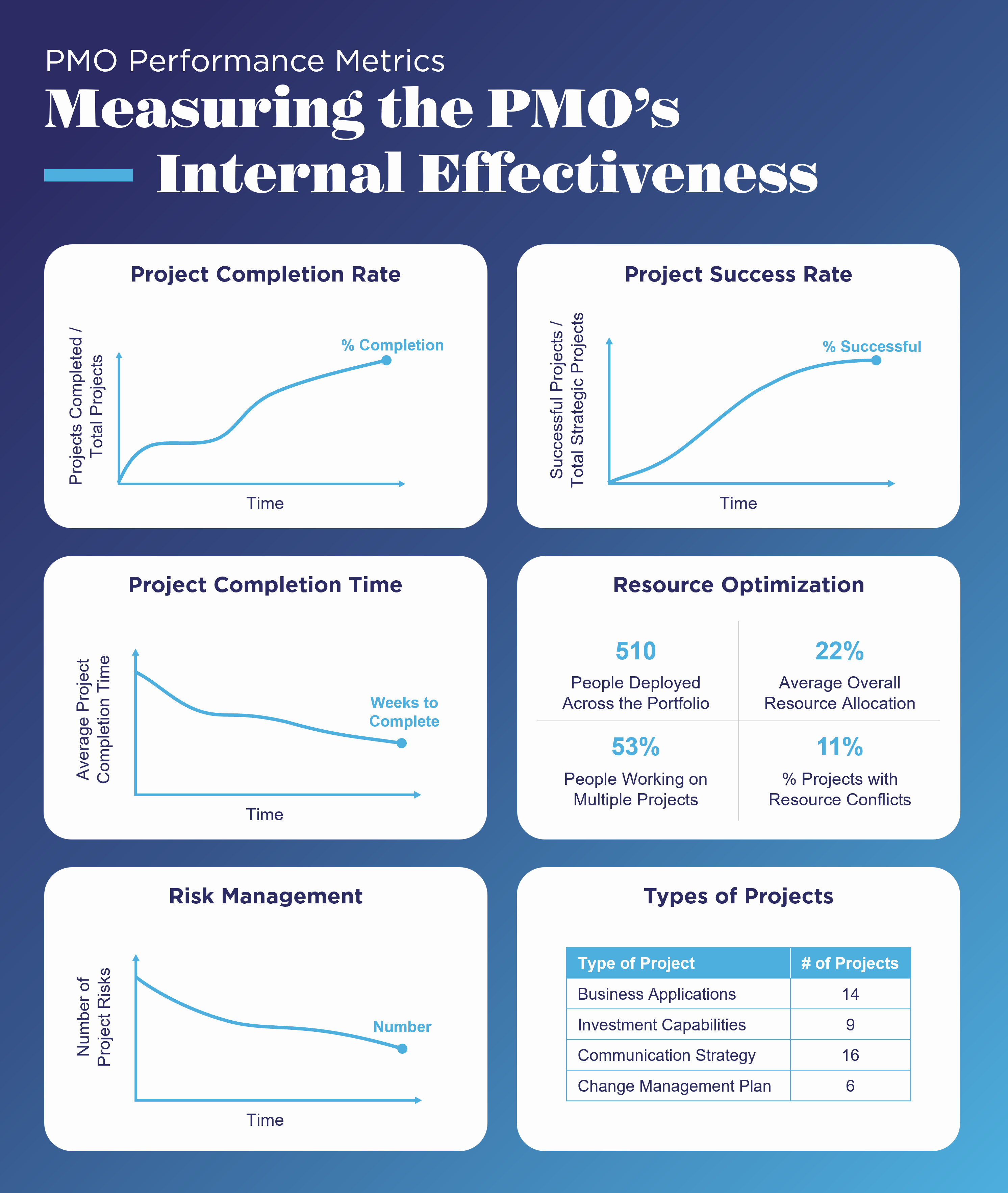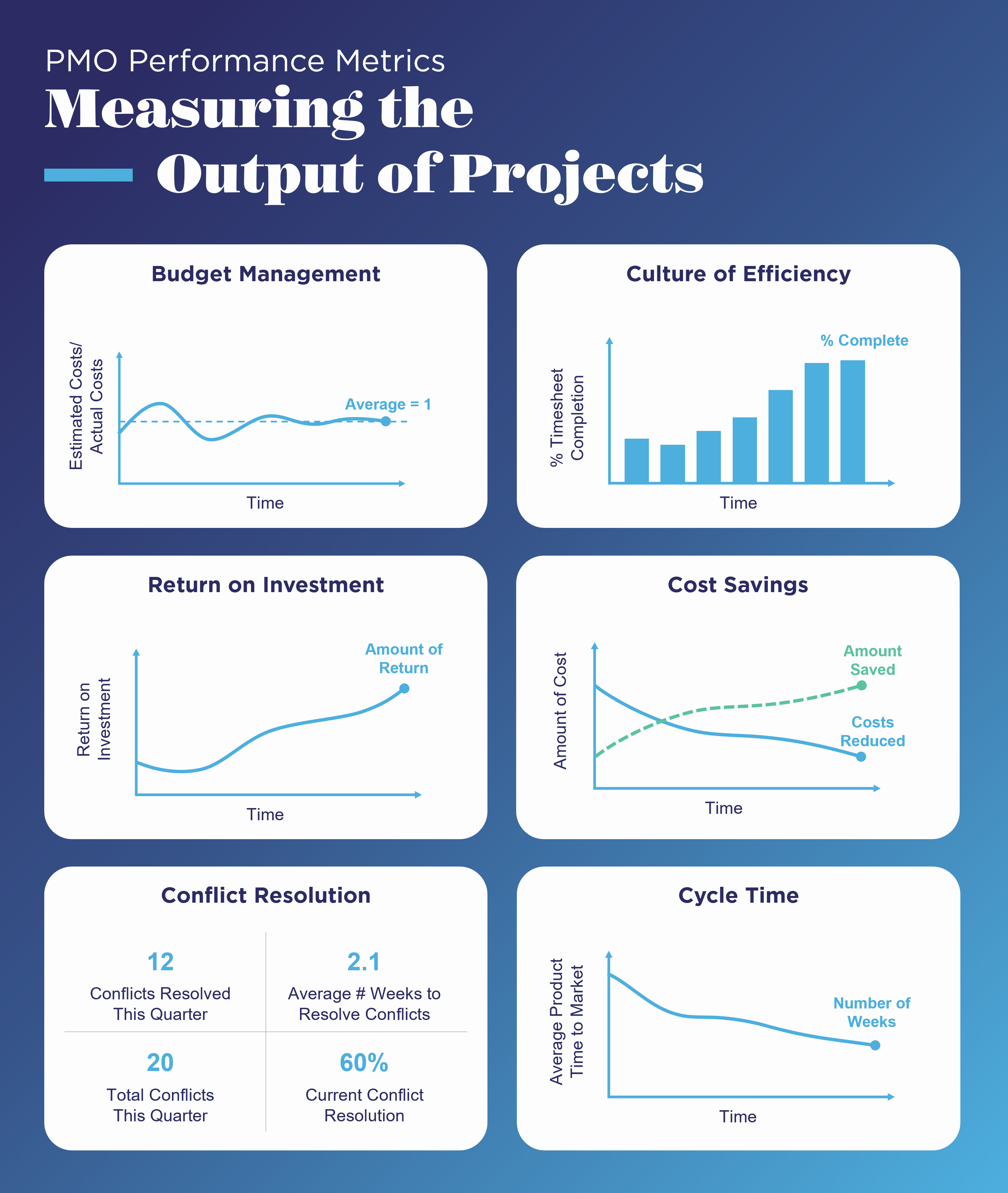PMO KPIs: Using metrics to measure PMO performance
Successful project management is all about delivering results for the business. But how can organizations most effectively measure those results? One way is to establish and track project portfolio management key performance indicators (KPIs) to evaluate project management office (PMO) performance.
Measurement is often the missing element of project management. Many organizations follow their project management processes but neglect to review the outcome of their efforts. According to Gartner¹, “Not only do PMO leaders need metrics and measures to report their organization’s activities accurately, but they also need to ‘sell’ the PMO’s usefulness and value to the enterprise.”
Table of Contents
PMO performance: Why KPIs are critical for PMOs
Traditionally, it has been difficult for PMOs to communicate the value they bring to the organization; therefore, it is common for the PMO to be viewed only as a bureaucratic, administrative entity. One challenge in proving its worth is that stakeholders each have different expectations and definitions of success. Another is finding the right KPIs to measure value, aligned with unified expectations. Too many can lead to confusion.
Instead, PMO performance metrics should be customized to provide specific data that helps the PMO explain how their activities bring value to the business, how it is improving, and where there may be opportunities for it to deliver even more value.
Determining which PMO leading indicators to track
KPIs for measuring PMO performance fall into two main categories:
- The internal effectiveness of the PMO and
- The output of projects.
PMO leading indicators will vary depending on the organization, the project objectives, and what is most important to each stakeholder; there is no standard set of PMO performance metrics. Many PMOs begin with an idea of what KPIs they want to measure and then work with stakeholders to customize them in reports and dashboards.
Let’s walk through some examples of indicators that help to evaluate PMO performance. It is worth noting that this list of KPIs does not apply to all projects but is an excellent directional guide for thinking about which ones to measure and convey project impacts. For example, a project that is intended to increase revenue will likely not reduce costs at the same time.
1. PMO Performance Metrics: Measuring the PMO's Internal Effectiveness
This category includes the day-to-day assessments of a PMO. Many of these performance indicators can be considered “table stakes” because they provide an essential list of qualities that all PMOs should excel at within companies of all sizes. Still, additional or different PMO leading indicators may be necessary for your stakeholders.

If in doubt, it is a good idea to present these PMO metric examples to each stakeholder to see which ones they would value. If measuring project portfolio management KPIs is somewhat new to the organization, many stakeholders may not be sure of what measurements would be helpful until they are given examples. The below performance indicators may serve to spark ideas for additional KPIs.
Project completion rates: One of the most basic measures of how well a PMO is functioning is the percentage of projects that are completed as a ratio of all the projects in a portfolio. More illustrative is how many of the projects are completed within the timeframes budgeted for the projects.
Project success rates: Naturally, companies have goals to complete projects successfully, however “success” is defined. This PMO performance metric includes the ratio of successful projects to all the projects in a portfolio. It could also measure strategic contributions by evaluating the success rate of strategic projects completed as a percentage of the total number of strategic projects.
Project completion time: Another consideration is whether the PMO is improving time-to-market for projects such as application development. The PMO can increase the speed at which projects are completed and products delivered, which can lead to increased sales, a competitive advantage, and higher customer satisfaction rates. If the PMO does a better job of keeping project teams on or ahead of schedule, they are more likely to complete projects quickly.
Resource optimization: How efficiently the PMO deploys resources as part of the project portfolio is an important measure of success. How well resources are optimized and can be demonstrated by demand per project type, employee-contractor ratio, allocated hours by project, cost by role, etc. Another good indicator for proper resource utilization is the number of people working on multiple projects. Finally, the way a PMO resolves resource conflicts and skill gaps is a key factor in its success. One way to measure this is to track the number of projects with existing resource conflicts and compare that with previous years.
Risk management: Every project in a portfolio carries some level of risk, and the PMO must be able to effectively manage and mitigate risk to the extent that it is possible. Tracking how various risks trend over quarters or years is also essential. This is why monitoring project portfolio management KPIs is so beneficial: it reveals risks that otherwise may be missed.
Types of projects: There is bound to be a variety of projects underway at any given time. This PMO performance metric shows whether a PMO is flexible and understands that work can be done in many ways, depending on who is doing the work. By giving the project teams (who are doing the work) the autonomy to deliver the work in their way versus trying to control every detail of the work, a PMO can maximize the potential of work aligned to strategy.
2. PMO Performance Metrics: Measuring the Output of Projects
This category is more of a reflection of how mature an organization is regarding its PMO function. It includes several leading indicators of the tangible returns that projects deliver for organizations. It also includes areas such as managing hurdles, which could also fall into the first category but often directly impact the output of projects.

Again, these are only metric examples. After all, regarding PMO performance metrics, one size does not fit all. Every organization and stakeholder will likely want to see different KPIs or a variation of the ones mentioned below. Partner with stakeholders to learn what measurements would give them the information they need to gain greater visibility.
Budget management & tracking: One of the most critical aspects of the PMO function is managing budgets; that is, keeping track of how money is being spent and determining whether the expenses exceed the original cost plans. A key measure of budget management is whether projects are on track to be completed on time and within budget. Companies should look at the ratio of estimated project costs to the actual costs of projects and the improvement of estimated costs versus the actual costs for projects over time.
Creating a culture of efficiency: For projects to be successful, PMOs need to run efficient operations. That means creating a culture in which employees take care of their responsibilities as part of the progress of projects. For example, a high percentage of timesheet completion means that the PMO is getting support from stakeholders – top-down and bottom-up – and that the process is not complicated by rules and policies that make collecting such information difficult.
Return on investment: Another PMO leading indicator is measuring how much revenue the PMO contributes to the company directly (or indirectly through the results of other parts of the organization) and how that revenue contribution has changed over time. This KPI would clearly be a measure of the business value the office is adding. For example, companies could measure the ROI on the investment managed by a PMO for projects with a financial return.
Cost savings: How much money the PMO saves the organization is also a good measure of business value. This includes reducing the costs associated with projects and managing those projects, which can come from increased efficiencies and better use of resources. Measuring these savings over time is another way to measure effectiveness.
Managing hurdles & challenges: The PMO will encounter a host of hurdles, likely daily. How effectively management addresses these challenges and resolves them quickly are other good measures of PMO success.
Cycle time/throughput: This metric applies more to Agile development teams from which the PMO gathers project information. It is essential to continuously improve the processes of these teams and speed up the delivery of final products to the market. As mentioned earlier, improving time-to-market for new products and services is an essential measure of the function of a PMO.
Ensuring Delivery Satisfaction
The PMO impacts more employees than meets the eye, including both those working directly on projects and those affected by the projects in some way. A good metric example is to conduct surveys of project workers to reveal insights on how the PMO improves their work experience and provides support. Employee satisfaction levels can even be compared over time to see if the PMO is improving its ability to meet stakeholders’ expectations.
In addition to supporting its own employees, how well is the PMO delivering customer satisfaction? Customers can be internal or external, and projects might be aimed at specific customers or an entire group. Either way, feedback from these sources via a survey, for example, is a crucial PMO metric that measures how well the PMO delivers value to those people and, ultimately, the business as a whole.
KPIs are Vital – Don't Neglect Them
Organizations that measure how well their PMO is functioning are more likely to see improved project performance and gain a competitive advantage. Without the right performance metrics, it is impossible to improve, let alone illustrate its value to the business. To gain credibility and become an integral part of the business, the PMO must measure the right project portfolio management KPIs and present itself in a way that makes sense to its stakeholders.
Using the right mix of performance metrics, companies can make evaluations that lead to fewer project failures, higher productivity, lower costs, and happier employees, to name a few. Which KPIs the PMO tracks may change over time; however, the critical thing to remember is that these metrics matter to many project stakeholders and should be a key part of running a successful PMO.
This article was written by Alf Raju, Commercial Director at MIGSO-PCUBED USA.
[1] Mieritz, L. (2015). Establishing and Fine-Tuning Effective PMO Metrics. Gartner (G00290904).
Loved what you just read?
Let's stay in touch.
No spam, only great things to read in our newsletter.



